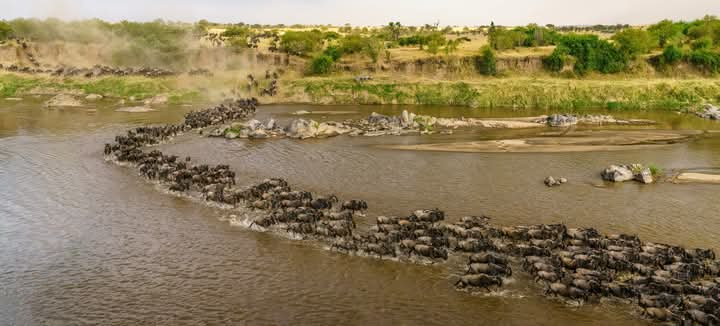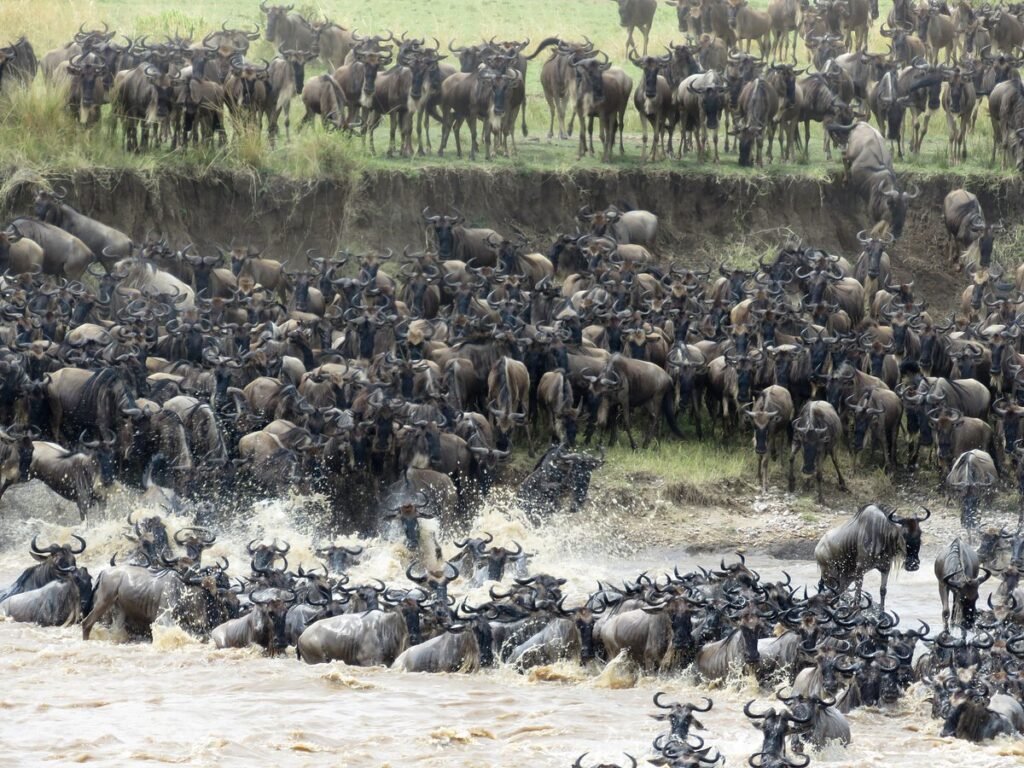The Ultimate Guide to the Mara River Safari
What is the Mara River?
The Mara River is one of Africa’s most iconic safari destinations, stretching over 395 km (245 miles) across Kenya and Tanzania. Flowing through the Masai Mara National Reserve in Kenya and the Serengeti National Park in Tanzania, it plays a crucial role in the Great Wildebeest Migration, one of the world’s most awe-inspiring wildlife events.
The river is famous for its dangerous crossings, where thousands of wildebeest, zebras, and gazelles brave the treacherous waters filled with massive Nile crocodiles and strong currents.
🔹 Location: Kenya & Tanzania
🔹 Best Known For: Wildebeest Migration Crossings
🔹 Wildlife: Crocodiles, hippos, lions, elephants, leopards



The Great Wildebeest Migration at the Mara River
The Great Migration is the largest overland wildlife migration in the world, where over 1.5 million wildebeest, along with thousands of zebras and gazelles, travel from the Serengeti in Tanzania to the Masai Mara in Kenya in search of fresh grazing lands.
📍 Where Do the Crossings Happen?
The crossings mainly take place at several key points along the Mara River, particularly in the Mara Triangle, where steep banks and deep waters make for dramatic, heart-pounding moments.
🌍 Why is it So Dangerous?
✅ Nile Crocodiles: Some of Africa’s largest crocs lurk beneath the surface, waiting for their prey.
✅ Strong Currents: Many animals drown due to the powerful water flow.
✅ Predators Waiting on Land: Lions, cheetahs, and hyenas lie in wait for exhausted animals.
🔹 Did You Know? Only about 1 in 10 wildebeest survive their first migration due to these harsh conditions.
Best Time to Visit the Mara River for the Migration
Timing your visit right is crucial if you want to witness a dramatic river crossing.
| Month | Migration Stage | Safari Experience |
|---|---|---|
| June – July | Wildebeest arrive from Serengeti | Animals gather near the Mara River |
| July – October | Peak river crossings | Best time to see dramatic action |
| November – December | Wildebeest return to Serengeti | Quieter safaris, fewer tourists |
| January – March | Calving season in Serengeti | Best time for predator action |
| April – May | Rainy season | Lush landscapes, but challenging travel |
💡 Tip: Stay near Mara Triangle for the best chance of seeing a river crossing!
How to Get to the Mara River
By Air (Fastest Option)
✈️ Fly from Nairobi (Wilson Airport) to Masai Mara
✔ Flights take about 45 minutes
✔ Land at Keekorok, Serena, or Ol Kiombo airstrips
✔ Best for travelers looking for a quick and scenic route
By Road (Budget-Friendly Option)
🚙 Drive from Nairobi to Masai Mara
✔ Distance: 250 km (155 miles)
✔ Takes 5-6 hours via Narok town
✔ Best for adventure travelers who want to see Kenya’s countryside
Need help booking a transfer? Contact us for private safari transport!
Wildlife & Safari Experience at the Mara River
While the wildebeest migration is the main attraction, the Mara River is teeming with other wildlife:
✅ Nile Crocodiles – These massive crocs wait patiently for their prey.
✅ Hippos – Found in large pods, these animals spend most of their time in the water.
✅ Big Cats (Lions, Leopards, Cheetahs) – Watch thrilling predator-prey chases.
✅ Elephants & Buffaloes – Often seen grazing near the riverbanks.
✅ Birdlife – Over 450 bird species, including African fish eagles and kingfishers.
🔹 Best Safari Activities at the Mara River:
✔ Game Drives – Spot the Big Five and the Great Migration.
✔ Walking Safaris – Explore with Maasai guides for a unique experience.
✔ Hot Air Balloon Safaris – Get a bird’s-eye view of the river crossings.
Where to Stay Near the Mara River
For the best safari experience, stay in a lodge or tented camp near the river.
Luxury Lodges & Camps
🏕 Mara Serena Safari Lodge – Overlooks the river with stunning views.
🏕 Governor’s Camp – Famous for wildlife-rich surroundings.
🏕 Angama Mara – Ultra-luxurious with a private safari experience.
Mid-Range & Budget Options
🏕 Ashnil Mara Camp – Perfect blend of comfort & affordability.
🏕 Mara River Lodge – Close to prime migration viewing spots.
🏕 Fig Tree Camp – Budget-friendly but still offers amazing wildlife access.
💡 Tip: Book early (6+ months in advance) during migration season to secure a good spot!
📞 Book Your Mara River Safari Today!
Ready to witness the Great Migration up close? Let us help you plan an unforgettable Mara River safari adventure.
📩 Get a Free Quote | 📞 WhatsApp Us
📍 Follow us on: Facebook | Instagram | TripAdvisor


